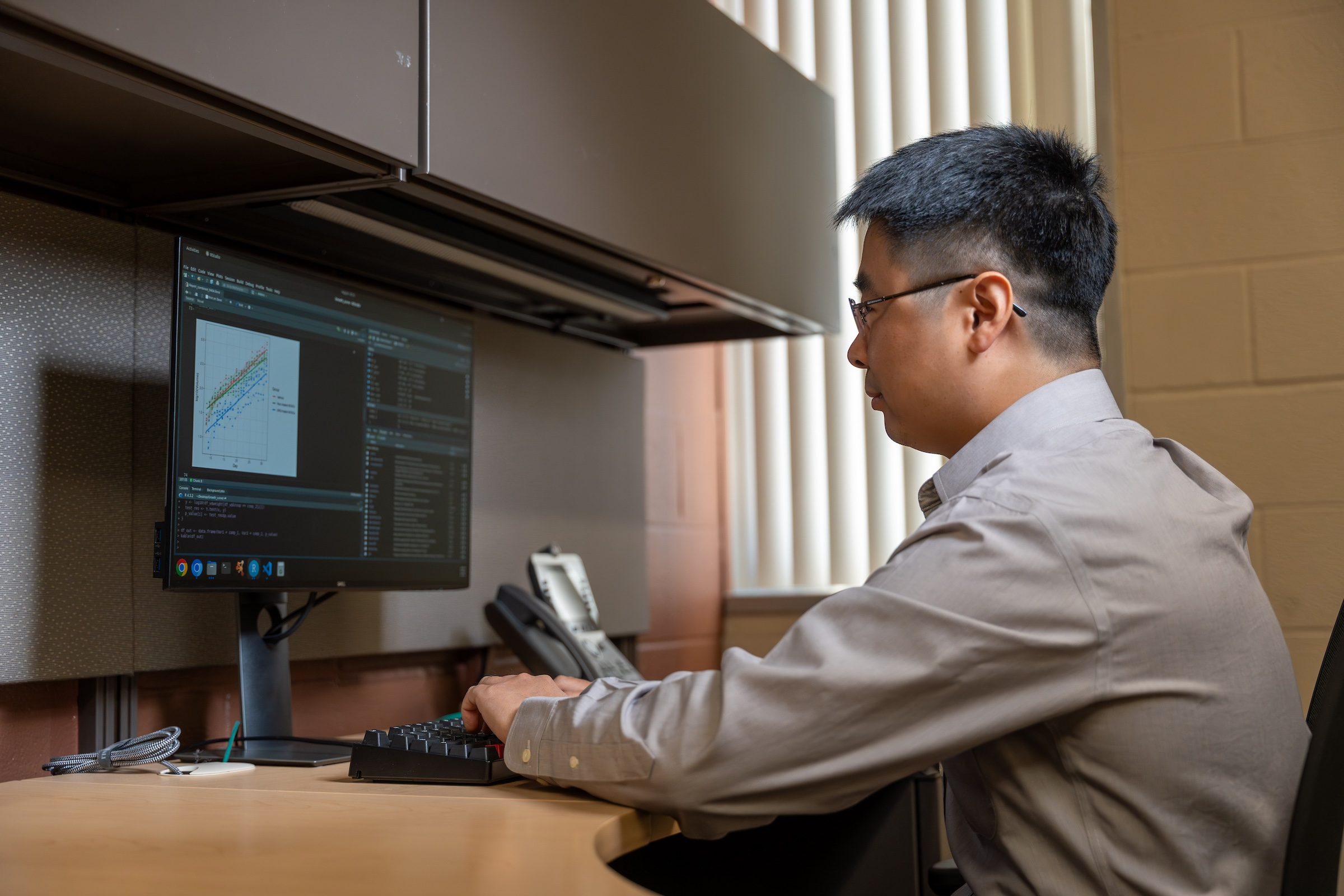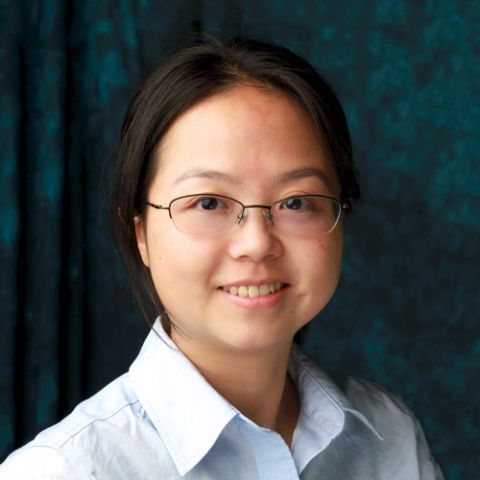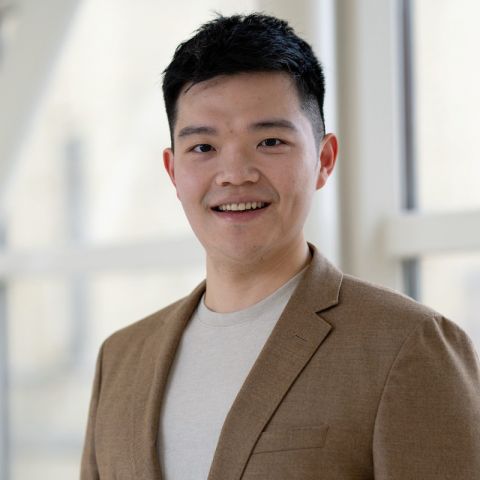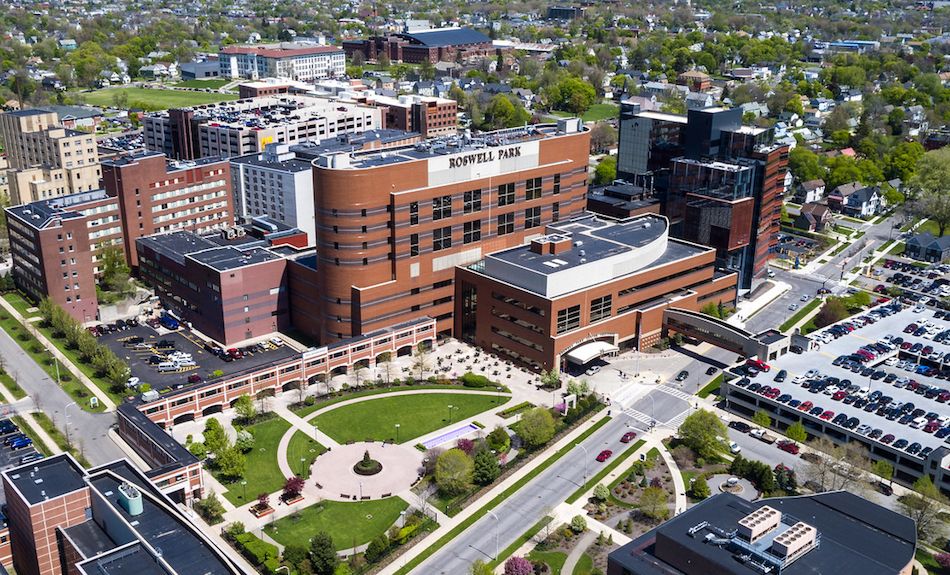What we do
The mission of the Biostatistics & Statistical Genomics Shared Resource (BSGSR) is to collaborate in the design, oversight, implementation, analysis, publication, and reporting of scientific studies by Roswell Park Comprehensive Cancer Center faculty and staff.
This includes articulating study objectives and hypotheses, grant writing, conceiving appropriate cost-effective designs and models for achievement of study objectives, assuring that modern and appropriate statistical methods are used, monitoring interim and final analyses, and co-authoring abstracts and manuscripts.
The expertise within the resource spans the full range of biostatistics, molecular epidemiology and statistical genetics and genomics.
- Biomarker development
- Bootstrap and resampling methods
- Clinical trials design and analysis
- Computationally intensive methods
- Diagnostic testing
- Epidemiological statistical methods
- Exact testing
- Longitudinal data methods
- Mathematical statistics
- Measurement error modeling
- Monte Carlo simulation
- Non-linear modeling
- Statistical education
- Survival and censored data methods
The BSGSR includes expertise in statistical genetics and genomics and collaborates closely with the Bioinformatics Shared Resource and the Biomedical Research Informatics Shared Resource. Collaborative projects frequently span these four areas — biostatistics, genetics and genomics, bioinformatics and database development — and the three teams work together in addressing the often overlapping scientific questions under study.
For clinical trials, BSGSR works closely with the investigator and Clinical Research Services (CRS) on all phases of a trial. From protocol development, clinical trial database development, study monitoring and interim analyses, to final analyses and trial reporting (including clinicaltrials.gov).
To request biostatistical support, please place a request using the Laboratory Information Management System (LIMS).
Technology
Biostatistics & Statistical Genomics Equipment:
- Microcomputer Workstations
- SAS® Software
- R Statistical Computing Software
- Mathematica®
- PASS Power Analysis and Sample Size Software
- PERL
- Shell
- Plink
- GATK
- Linux high-performance computing cluster (1,600 processors, 200 TB storage)
Services and fees
Services include:
- Exploratory data analysis
- Grant writing (statistical methods sections)
- Hypothesis formulation
- Clinical trial design
- Experimental design
- Fitting models to data
- Developing novel statistical methods
- Reporting of results to clinicaltrials.gov
- Developing customized data mining software and developing novel methods based on emerging technologies (e.g., cutting edge microarray platforms, computer intensive statistical methods)
- Statistical training and education
- Statistical programming and database development
- Statistical software development
- Graphical presentation of results
- Manuscript writing
Priority is given to Cancer Center Support Grant (CCSG) members and investigators who have outside funding, an approved clinical trial, or are preparing protocols and/or grant applications.
Fee policy
- No fees or chargebacks for consultative/development services
- Appropriate percent effort on grants
Meet our team
Kayla Catalfamo, MA
Biostatistician
Phone: 716-845-1300 ext. 7217
Email: Kayla.Catalfamo@RoswellPark.org
Adrienne Groman, MS
Senior Biostatistician
Phone: 716-845-1300 ext. 6274
Email: Adrienne.Groman@RoswellPark.org
Zhe Jing, MA, MPH
Senior Biostatistician
Phone: 716-845-1300 ext. 2589
Email: Zhe.Jing@RoswellPark.org
Ram Nambiar, MS
Biostatistician
Phone: 716-845-1300 ext. 2216
Email: Ram.Nambiar@RoswellPark.org
Katy Wang, MA
Senior Biostatistician
Phone: 716-845-1300 ext. 6269
Email: Katy.Wang@RoswellPark.org
Lacey Yuan, MA
Biostatistician
Phone: 716-845-1300 x 2652
Email: Guangwei.Yuan@RoswellPark.org
Location & hours
Roswell Park Comprehensive Cancer Center
Biostatistics & Statistical Genomics Shared Resource
Research Study Center - 4th Floor
Elm and Carlton Streets
Buffalo, New York 14263
Monday – Friday, 8 a.m. – 5 p.m.
This shared resource is funded by NCI P30CA16056. Publications should cite the core grant in the acknowledgment section if publications use data generated by the shared resource. Two copies of the publication acknowledging the core grant should also be submitted to the facility at Elm and Carlton Streets, Buffalo, NY 14263.
The Biostatistics & Statistical Genomics Resource (BSGSR) ensures that biostatistical support is readily available to basic, clinical, and population-oriented Roswell Park Comprehensive Cancer Center collaborators. Services include exploratory data analysis, grant writing, hypothesis formulation, experimental design, fitting models to data, simulating data from models, and developing novel methods based on emerging technologies. In addition, the BSGSR develops novel statistical methodologies and software applications for the analysis of data generated by experiments utilizing emerging biotechnologies. Further, the BSGSR will assist in the development and optimal design of nascent biotechnologies at Roswell Park.
Selected publications
- Hutson, A. and Yu, H. (2021) A Robust Permutation Test for the Concordance Correlation Coefficient. Pharmaceutical Statistics (in press). …available online
- Hutson, A. D. and Vexler, A. (2018) A Cautionary Note on Beta Families of Distributions and the Aliases Within. The American Statistician, 72 121-129.
- Mark Farrugia, Han Yu, Sung Jun Ma, Austin J. Iovoli, Kristopher Attwood, Kimberly E. Wooten, Hassan Arshad, Vishal Gupta, Ryan P. McSpadden, Moni A. Kuriakose, Micheal R. Markiewicz, Jon M. Chan, Wesley L. Hicks Jr, Mary E. Platek, Andrew D. Ray, Elizabeth A. Repasky, Anurag K. Singh. A Principal Component of Quality of Life Measures is Associated with Survival for Head and Neck Cancer Patients Treated with Radiation Therapy. Cancers. (In press). https://doi.org/10.3390/cancers13051155
- Ranjan Pathak, Gilberto De Lima Lopes, Han Yu, Madan Raj Aryal, Wenyan Ji, Katherine Stemmer Frumento, Christopher JD Wallis, Zachary Klaassen, Henry S Park, Sarah B Goldberg. Comparative efficacy of chemoimmunotherapy versus immunotherapy for advanced non–small cell lung cancer: A network meta‐analysis of randomized trials. Cancer. 2021; 127(5):709-719. PMID: 33119177
- Mi Yang and Francesca Petralia, Zhi Li, Hongyang Li, Weiping Ma, Xiaoyu Song, Sunkyu Kim, Heewon Lee, Han Yu, Bora Lee, Seohui Bae, Eunji Heo, Jan Kaczmarczyk, Piotr Stepniak, Michal Warchol, Thomas Yu, Anna P. Calinawan, Paul C. Boutros, Samuel H. Payne, Boris Reva, NCI-CPTAC-DREAM Consortium, Emily Boja, Henry Rodriguez, Gustavo Stolovitzky, Yuanfang Guan, Jaewoo Kang, Pei Wang, David Fenyo, Julio Saez-Rodriguez. Community Assessment of the Predictability of Cancer Protein and Phosphoprotein Levels from Genomics and Transcriptomics. Cell Systems. 2020; 11 (2), 186-195. PMID: 32710834
- Han Yu, Janhavi Moharil, Rachael Hageman Blair. BayesNetBP: An R package for probabilistic reasoning in Bayesian Networks. Journal of Statistical Software. 2020; 94(3), 1–31.
- Lina Mu, Zhongzheng Niu, Rachael Hageman Blair, Han Yu, Richard W Browne, Matthew R Bonner, Tiffany Fanter, Furong Deng, Mya Swanson. Metabolomics profiling before, during, and after the Beijing Olympics: a panel study of within-individual differences during periods of high and low air pollution. Environmental health perspectives. Environmental Health Perspectives. 2019; 127(5): 057010. PMID: 3114088
- Zhu et al. Whole-exome sequencing of ovarian cancer families uncovers putative predisposition genes. International Journal of Cancer. 2020.
- Yao & Zhu et al. Genetic Ancestry and Skeletal Toxicities among Childhood Acute Lymphoblastic Leukemia Patients in the DFCI 05-001 Cohort. Blood Advances. 2020
- Attwood K and Tian L. Confidence Interval Estimation of the Youden index and corresponding cut-point for a combination of biomarkers under normality. Communications in Statistics – Theory and Methods. 2020. DOI: 10.1080/03610926.2020.1751852.
- Zsiros E, Lynam S, Attwood KM, Wang C, Chilakapati S, Cortes Gomez E, Liu S, Akers S, Lele S, Frederick PJ and Odunsi K. Efficacy and Safety of Pembrolizumab in Combination With Bevacizumab and Oral Metronomic Cyclophosphamide in the Treatment of Recurrent Ovarian Cancer: A Phase 2 Nonrandomized Clinical Trial. JAMA Oncology 2021; 7(1): 78-85.
- Shah R, Attwood K, Arya S, Hall DE, Johanning JM, Gabriel E, Visioni A, Nurkin S, Kukar M, Hochwald S and Massarweh NN. Association of Frailty With Failure to Rescue After Low-Risk and High-Risk Inpatient Surgery. JAMA Surgery. 2018; 153(3): e180214.







